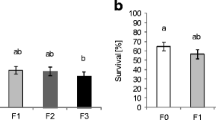Abstract
Regrowth after clipping and the effect of local competition were studied in a natural population of Erica multiflora in a Mediterranean shrubland, by removing neighbours at 1 and 2 m around the target plants during four growing seasons. Removal of surrounding natural vegetation increased the number, the density (number of sprouts per stump area) and the biomass of the sprouts growing from clipped plants. Target plants ònly interacted with their near neighbours. Target plants had a negative relative increment in the number of sprouts per stump during the 18 months immediately following treatment, but a positive increment thereafter, which suggests that there was a constant or episodic recruitment of sprouts within the stump after clipping. Competition treatment had a non-significant effect on the negative increment of sprouts per stump. The self-thinning trajectory was different for the different competition treatments: there was an allometric negative relationship between density of sprouts and mean biomass of survivors during all sampling periods in genets without neighbours in a 1-m radius; the self-thinning trajectory of sprouts in genets without neighbours in a 2-m radius was short, a net increase in sprouts per stump area was accompanied by an increase in mean sprout biomass 30 months after clipping. During the same period, however, plants with neighbours showed a decline in both the sprout biomass and density.
Similar content being viewed by others
References
Auld TD (1990) The survival of juvenile plants of the resprouting shrub Angophora hispida (Myrtacea) after a simulated lowintensity fire. Aust J Bot 38: 255–260
Ford ED, Newbould PJ (1970) Stand structure and dry weight production through the sweet chestnut (Castanea sativa Mill.) coppice cycle. J Ecol 58: 275–296
Fowler NL (1984) The role germination date, spatial arrangement, and neighbourhood effect in competitive interactions in Linum. J Ecol 72: 307–318
Giovannini G, Perulli D, Piussi P, Salbitano F (1992) Ecology of vegetative regeneration after coppicing in macchia stands in central Italy. Vegetatio 99–100: 331–343
Hartnett DC, Bazzaz FA (1983) Physiological integration among intraclonal “ramets” in Solidago canadensis. Ecology 64: 779–788
Harper JI (1977) Population biology of plants. Academic Press, New York
Hunt R (1982) Plant growth curves. Edward ArnoldLondon
Hutchings MJ (1979) Weight-density relationships in ramet populations of clonal perennial herbs, with special reference to the-3/2 thinning law. J Ecol 67: 21–34
James S (1984) Lignotubers and burls — their structure, function and ecological significance in Mediterranean ecosystems. Bot Rev 50: 226–266
Keeley JE, Zedler PH (1978) Reproduction of chaparral shrubs after fire. A comparison of the sprouting and seed strategies. Am Midl Nat 99: 142–161
Lonsdale WM, Watkinson AR (1982) Light and self-thinning. New Phytol 90: 431–445
Malanson GP, Westman WE (1985) Postfire succession in California coastal sage scrub: the role of continual basal sprouting. Am Midl Nat 113: 309–317
Marshall C (1990) Source-sink relations of interconnected ramets. In: Van Groenendael H, De Kroon H (eds) Clonal growth in plants: regulation and function. SPB Academic, The Hague, pp 23–41
McConnaughay KDM, Bazzaz FA (1987) The relationship between gap size and performance of several colonizing annuals. Ecology 68: 411–416
Mesléard F, Lepart J (1989) Continuous basal sprouting from a lignotuber: Arbutus unedo L. and Erica arborea L., as woody Mediterranean examples. Oecologia 80: 127–131
Mithen R, Harper JL, Weiner J (1984) Growth and mortality of individual plants as a function of “available area”, Oecologia 62: 57–60
Mook JH, Van der Toorn J (1982) The influence of environmental factors and management on stands of Phragmites australis. II. Effects on yield and its relationships with shoot density. J Appl Ecol 19: 501–517
Morris EC, Myerscough PJ (1984) The interaction of density and resource levels in monospecific blocks of plants: a review of hypotheses and evidence. Aust J Ecol 9: 51–62
Mueggler WF (1972) Influence of competition on the response of bluebunch wheatgrass to clipping. J Range Manage 20: 88–92
Novoplansky A, Cohen D, Sachs T (1989) Ecological implications of correlative inhibition between plant shoots. Physiol Plant 77: 136–140
Price EAC, Hutchings MJ (1992) The causes and developmental effects of integration and independence between different parts of Glechoma hederacea clones. Oikos 63: 376–386
Riba M (1991) Estudi de la regeneració per rebrotada en poblacions d'Erica arborea sotmeses a tallades. PhD thesis, Universitat Autònoma de Barcelona
Rosner B (1995). Fundamentals of biostatistics, 4th edn. Duxbury, Belmont
Rubinstein B, Nagao MA (1976) Lateral bud outgrowth and its control by apex. Bot Rev 42: 83–113
Sousa WP (1984) The role of disturbance in natural communities. Annu Rev Ecol Syst 15: 353–391
Thomas SC, Weiner J (1989) Growth, death and size distribution change in Impatiens pallida population. J Ecol 77: 524–536
Vilà M, Weiner J, Terradas J (1994) Effect of local competition on resprouting of Arbutus unedo after clipping. J Veg Sci 5: 145–152
Weiner J, Whigham DF (1988) Size variability and self-thinning in wild-rice (Zizania aquatica). Am J Bot 75: 445–448
Westoby M (1984) The self-thinning rule. Adv Ecol Res 14: 167–225
Wilson SC, Keddy P (1986) Species competitive ability and position along a natural stress/disturbance gradient. Ecology 67: 1236–1242
Yoda K, Kira T, Ogawa H, Hozumi K (1963) Intraspecific competition among higher plants. XI. Self-thinning in overcrowded pure stands under cultivated and natural conditions. J Inst Poly Osaka City Univ 14: 107–129
Author information
Authors and Affiliations
Corresponding author
Rights and permissions
About this article
Cite this article
Vilà, M., Terradas, J. Sprout recruitment and self-thinning of Erica multiflora after clipping. Oecologia 102, 64–69 (1995). https://doi.org/10.1007/BF00333311
Received:
Accepted:
Issue Date:
DOI: https://doi.org/10.1007/BF00333311




